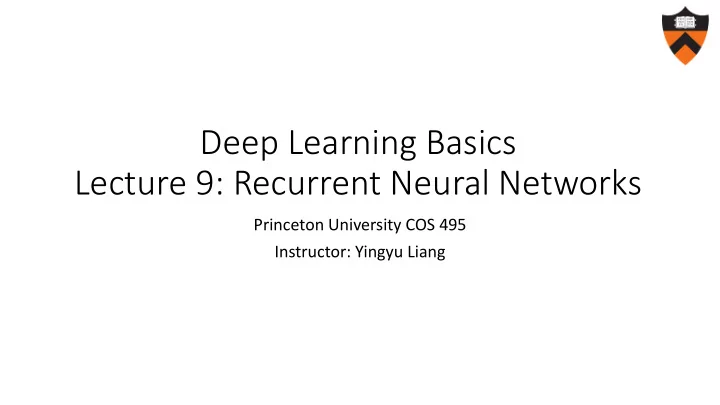

Deep Learning Basics Lecture 9: Recurrent Neural Networks Princeton University COS 495 Instructor: Yingyu Liang
Introduction
Recurrent neural networks • Dates back to (Rumelhart et al. , 1986) • A family of neural networks for handling sequential data, which involves variable length inputs or outputs • Especially, for natural language processing (NLP)
Sequential data • Each data point: A sequence of vectors 𝑦 (𝑢) , for 1 ≤ 𝑢 ≤ 𝜐 • Batch data: many sequences with different lengths 𝜐 • Label: can be a scalar, a vector, or even a sequence • Example • Sentiment analysis • Machine translation
Example: machine translation Figure from: devblogs.nvidia.com
More complicated sequential data • Data point: two dimensional sequences like images • Label: different type of sequences like text sentences • Example: image captioning
Image captioning Figure from the paper “ DenseCap : Fully Convolutional Localization Networks for Dense Captioning”, by Justin Johnson, Andrej Karpathy, Li Fei-Fei
Computational graphs
A typical dynamic system 𝑡 (𝑢+1) = 𝑔(𝑡 𝑢 ; 𝜄) Figure from Deep Learning , Goodfellow, Bengio and Courville
A system driven by external data 𝑡 (𝑢+1) = 𝑔(𝑡 𝑢 , 𝑦 (𝑢+1) ; 𝜄) Figure from Deep Learning , Goodfellow, Bengio and Courville
Compact view 𝑡 (𝑢+1) = 𝑔(𝑡 𝑢 , 𝑦 (𝑢+1) ; 𝜄) Figure from Deep Learning , Goodfellow, Bengio and Courville
square: one step time delay Compact view 𝑡 (𝑢+1) = 𝑔(𝑡 𝑢 , 𝑦 (𝑢+1) ; 𝜄) Key: the same 𝑔 and 𝜄 Figure from Deep Learning , for all time steps Goodfellow, Bengio and Courville
Recurrent neural networks (RNN)
Recurrent neural networks • Use the same computational function and parameters across different time steps of the sequence • Each time step: takes the input entry and the previous hidden state to compute the output entry • Loss: typically computed every time step
Label Recurrent neural networks Loss Output State Input Figure from Deep Learning , by Goodfellow, Bengio and Courville
Recurrent neural networks Math formula: Figure from Deep Learning , Goodfellow, Bengio and Courville
Advantage • Hidden state: a lossy summary of the past • Shared functions and parameters: greatly reduce the capacity and good for generalization in learning • Explicitly use the prior knowledge that the sequential data can be processed by in the same way at different time step (e.g., NLP)
Advantage • Hidden state: a lossy summary of the past • Shared functions and parameters: greatly reduce the capacity and good for generalization in learning • Explicitly use the prior knowledge that the sequential data can be processed by in the same way at different time step (e.g., NLP) • Yet still powerful (actually universal): any function computable by a Turing machine can be computed by such a recurrent network of a finite size (see, e.g., Siegelmann and Sontag (1995))
Training RNN • Principle: unfold the computational graph, and use backpropagation • Called back-propagation through time (BPTT) algorithm • Can then apply any general-purpose gradient-based techniques
Training RNN • Principle: unfold the computational graph, and use backpropagation • Called back-propagation through time (BPTT) algorithm • Can then apply any general-purpose gradient-based techniques • Conceptually: first compute the gradients of the internal nodes, then compute the gradients of the parameters
Recurrent neural networks Math formula: Figure from Deep Learning , Goodfellow, Bengio and Courville
Recurrent neural networks Gradient at 𝑀 (𝑢) : (total loss is sum of those at different time steps) Figure from Deep Learning , Goodfellow, Bengio and Courville
Recurrent neural networks Gradient at 𝑝 (𝑢) : Figure from Deep Learning , Goodfellow, Bengio and Courville
Recurrent neural networks Gradient at 𝑡 (𝜐) : Figure from Deep Learning , Goodfellow, Bengio and Courville
Recurrent neural networks Gradient at 𝑡 (𝑢) : Figure from Deep Learning , Goodfellow, Bengio and Courville
Recurrent neural networks Gradient at parameter 𝑊 : Figure from Deep Learning , Goodfellow, Bengio and Courville
Variants of RNN
RNN • Use the same computational function and parameters across different time steps of the sequence • Each time step: takes the input entry and the previous hidden state to compute the output entry • Loss: typically computed every time step • Many variants • Information about the past can be in many other forms • Only output at the end of the sequence
Example: use the output at the previous step Figure from Deep Learning , Goodfellow, Bengio and Courville
Example: only output at the end Figure from Deep Learning , Goodfellow, Bengio and Courville
Bidirectional RNNs • Many applications: output at time 𝑢 may depend on the whole input sequence • Example in speech recognition: correct interpretation of the current sound may depend on the next few phonemes, potentially even the next few words • Bidirectional RNNs are introduced to address this
BiRNNs Figure from Deep Learning , Goodfellow, Bengio and Courville
Encoder-decoder RNNs • RNNs: can map sequence to one vector; or to sequence of same length • What about mapping sequence to sequence of different length? • Example: speech recognition, machine translation, question answering, etc
Figure from Deep Learning , Goodfellow, Bengio and Courville
Recommend
More recommend